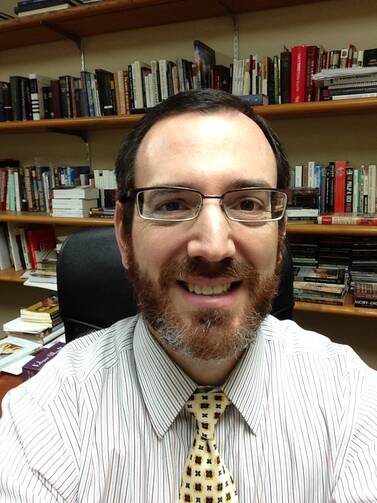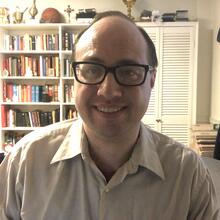Stephen Mirarchi is a Catholic layman, husband and father serving as assistant professor of English at Benedictine College in Atchison, Kan. Specializing in the intersection of theology and literature, he holds a Ph.D. in English and American literature from Brandeis University, and he did additional work in theology at Kenrick School of Theology in St. Louis and Creighton University in Omaha.
A former English and theology teacher at Jesuit High School of Tampa, Dr. Mirarchi has published articles on Edgar Allan Poe, Stephen Crane, Raymond Carver and Cormac McCarthy, as well as many short articles in the National Catholic Register.
Dr. Mirarchi recently wrote the introduction and annotations for a new scholarly edition of the classic American Catholic novel Mr. Blue (1928) by Hollywood screenwriter-producer Myles Connolly, published on April 14 by Cluny Media (ISBN: 9781944418076). Mr. Connolly’s surviving daughter, Mary Connolly Breiner, wrote a new preface for the book. On April 20, I interviewed Dr. Mirarchi by email about the new edition.
Loyola Press, under its Loyola Classics imprint, reprinted Mr. Blue in 2005. What inspired you to produce a scholarly edition of this often reproduced work?
I taught Mr. Blue for the first time in my “Christianity and Literature” class in the fall of 2014 and greatly enjoyed it. I taught it alongside G. K. Chesterton’s biography of St. Francis and noticed quite a bit of overlap, as if Connolly had consciously been drawing on Chesterton. That led me to start researching Mr. Blue and Connolly further, the idea being that I’d submit an article on the subject to an academic journal. The Loyola Classics edition went out of print in 2015. Later that year Cluny Media, through a mutual friend, approached me with the idea of reprinting classic Catholic books. Given the research I’d accumulated at that point, I proposed an annotated edition of Mr. Blue, and we started looking into it.
Myles Connolly’s book was once a standard text in many high school and college literature classes. What’s the message of this book and what makes it worth reading today?
The message of the book is threefold. First, consummation of joy comes in total self-offering to God and neighbor. Second, complete self-giving is a process that usually progresses in stages and in communion with others. Third, everything in creation participates in the glory of God. That threefold message is of utmost worth today, where joy is often figured as sophisticated hedonism, radical individualism, secular do-goodism and the like.
Similarly, Mr. Blue fights off the romanticized notions that saints are made overnight, that there’s a “one size fits all” path to holiness and that salvation is an individual affair. Finally, the book’s celebration of history, architecture, music, locale and plain old human effort is a testament to Connolly’s conviction that every created thing can be a help on the path of Christian ascent.
Who is your audience for this new edition?
First of all, the kind of reader who made the book successful in the first place: anyone looking for a great story about joyful service. The annotations were written to help explain just about anything your typical reader might not be immediately familiar with: Why was Pentecostalism significant in 1920s America? Why does the title character refer to the Tavern at the End of the World? How does Connolly play off the two meanings of the word “wens”? We hope people who already know the book will fall in love with it again by discovering its literary depths and its profound wisdom.
Second, the annotations contain references to scholarly sources, and the introduction covers the 90 years of scholarship on Mr. Blue. We’re hoping students and professors alike will find these resources to be inspiring for classroom discussion and will initiate a whole new wave of academic dialogue.
This book is often described as a classic work of “Catholic fiction.” What does “Catholic fiction” mean to you in the context of this book?
Connolly hits on two facets of Catholic fiction quite well in Mr. Blue. First, he balances the interplay between the universalism of “catholic” and the specific teachings of Catholicism. There’s an exquisite depiction, for instance, of the Mass in Mr. Blue; you can learn a lot about the liturgy if you pay attention there. Yet, that scene occurs in the context of a dystopian tale, a genre that necessarily concerns humanity in general. Connolly balances them, as Chesterton says the church always does, on a knife’s edge.
Second, Connolly understands that spiritual warfare in the Catholic tradition is not reducible to psychology, nor merely to battles with the demonic, but involves the world and the flesh as well. Throughout the book we see the protagonists struggling to discern which spirits are acting upon them, and which to reject and which to accept. Connolly did graduate from Boston College, so it’s not surprising that he has some chops when it comes to spiritual discernment.
What is your interpretation of the book’s literary structure?
I cover this in depth in Part II of my introduction. I’ll give a hint here: It has to do with Connolly’s well-documented love of Irish literature, as well as his competitiveness with F. Scott Fitzgerald. Connolly’s structure for Mr. Blue is marvelously simple and ingenious—a lot like Connolly himself, and the writers he admired like Chesterton and Belloc.
You prepared more than 200 annotations for this edition on the historical, theological, literary and regional threads of Connolly’s narrative. What can you tell us about these threads?
The more research I did to prepare them, the more I realized that Connolly deserves a higher place in the literary world than he’s currently afforded. Not many popular fiction writers can give you a precise distinction between dryness and dullness in the spiritual life, yet Connolly has Blue speak of these spiritual states to help his narrator-friend realize the failure of modern architecture.
Connolly was precise in his word choice: I had to consult the Oxford English Dictionary frequently to track down historical meanings, and it seems like I learned something new every time. In one passage, the narrator remarks how Blue reached out to the “derelicts” who others would consider “wastrels.” The former term had a neutral sense in Connolly’s time, while the latter didn’t; Connolly’s point is that Blue saw Christ in those we easily overlook or disregard—not because we look down on them but simply out of our own preoccupation, like the rich man with the poor Lazarus at his gate. Given how “derelict” has taken on a predominantly negative nuance in our own time, we could easily misconstrue Connolly’s point here.
There are all kinds of wonderful moments like this to discover in the book, such as when Connolly makes architectural puns, appreciates with a keen eye his native Boston or takes his two characters on an American Revolution-inspired Way of the Cross. Mr. Blue is the product of a lively, powerful mind steeped in a love of the fine arts, with a view to their power to draw us to intimacy with God and neighbor.
How did your collaboration with the Connolly estate and family unfold?
Alton Pelowski, the editor of Columbia, the Knights of Columbus magazine, had done an interview with the family in 2014 as part of an article on Myles Connolly. Connolly had once edited Columbia himself, well enough to get the magazine banned from Mexico during the Catholic persecutions there in the 1920s. Pelowski mentioned in his piece a newspaper article I wasn’t able to locate, so I simply cold-called him to ask him about it. We hit it off, and he offered to send a copy of the newspaper article to me—very generous.
When the time came to consult the Connolly estate for permission to reprint Mr. Blue, I went through Pelowski, who looked over my research and was able to credibly vet me. From there, Cluny presented the Connollys with our vision, and everything proceeded amicably and professionally. After she read our introduction and annotations, Mary Connolly Breiner told us she’d learned things about her father and Mr. Blue that she’d never known. That’s when we started getting excited. The Connollys were so happy with our edition, in fact, that they have given us permission to reprint all of Myles Connolly’s works, which we plan to do one at a time over the next few years.
If you could tell Pope Francis one thing about Myles Connolly and this book, what would it be?
If I could actually utter words in his presence, I would try to tell Pope Francis that the title character of the book, Blue, is mercy in action. Blue’s joyful progress in the spiritual life is largely a result of his showing great mercy to everyone he meets. Connolly understood that sometimes mercy means a gentle admonishment between friends, as when Blue tells the narrator, ironically, that gluttony is his best virtue. Connolly moreso understood that mercy means going in person to those in greatest need—often those that society is most ready to ignore or spurn—and giving them your whole self, unreservedly, in great hope and rejoicing.
What’s your favorite Scripture passage and why?
My favorite use of Scripture in the novel is when Connolly weaves several details together to compare Blue’s humble rooftop residence to the fog-covered tent that Moses would enter to meet the Lord (Ex 33:7-9).
As for my own favorite Scripture passage in general? Many—they come and go with our spiritual seasons—but one that stays with me is Psalm 119:32b, Cum dilatasti cor meum. God’s enlarging the heart, the soul, the understanding, as it’s alternatively translated—St. Teresa of Ávila speaks of this verse to distinguish between particular states of prayer. Don’t we find, when we understand a work of literature better, that our hearts are dilated? Don’t we experience awe when we look at the history of a work of art and marvel at its “practical wisdom,” as the Catechism terms it? I hope readers will experience something of these consolations when they encounter Blue as this edition illuminates him.
Any final thoughts?
Many amazing things happened in the production of this edition. At one point in the novel Blue quotes a poem by Hilary Pepler, an early 20th-century writer and printer who worked closely with Chesterton and his crew. As I was preparing the annotation for that reference, I found that the poem was nowhere to be found. Anyone who reproduced it was copying it from Mr. Blue, and that was no help. Additionally, the poem could have come from several of Pepler’s books. Even the obscure art catalogs I managed to dig up that referenced Pepler weren’t crystal clear about which book of his the poem was in. To further complicate matters, the book that my best guess pointed to was printed in only 200 copies in 1926, of which only 42 were now available in libraries worldwide.
As it turns out, one of these very rare copies was housed at Fort Hays State University, a four-hour drive west of me. How they had one I’ll never know; the other copies were in predictable, inaccessible places like Trinity College Dublin and the Boston Athenaeum. You know what I did, of course: I requested it through Interlibrary Loan. And Fort Hays sent it! I cradled this hand-printed prize as I showed it to every librarian on our campus, and thankfully my research was correct: The poem was in there. There were a couple variants, however, from the version in Mr. Blue, so the adventure continues. What an act of generosity on Fort Hays’ part to send that book our way and trust us with it, so I could complete my research. I think Blue would be proud.
Sean Salai, S.J., is a contributing writer at America.







